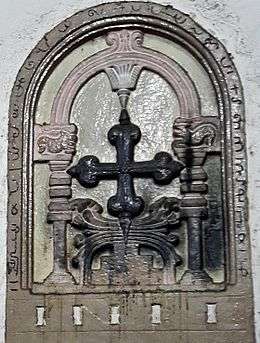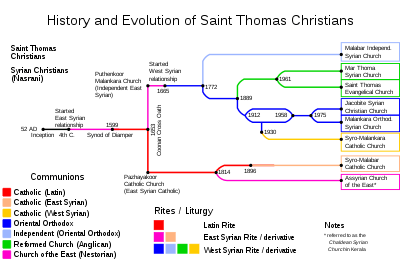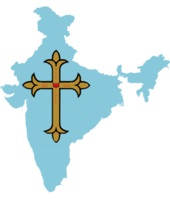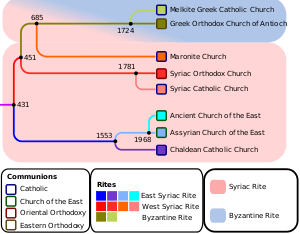Chaldean Syrian Church
The Chaldean Syrian Church of India (Classical Syriac: ܥܕܬܐ ܕܡܕܢܚܐ ܕܐܬܘܖ̈ܝܐ; Malayalam: കൽദായ സുറിയാനി സഭ) is an Eastern Christian Church based in Thrissur, India. It is an archbishopric of the Assyrian Church of the East and is in full communion with Catholicos-Patriarch Mar Gewargis III. The Assyrian Church of the East descends from the historic Church of the East.[3]
| Chaldean Syrian Church (of India) Holy Apostolic Catholic Assyrian Church of the East | |
|---|---|
| ܥܕܬܐ ܕܡܕܢܚܐ ܕܐܬܘܖ̈ܝܐ കൽദായ സുറിയാനി സഭ | |
 The Mar Thoma Sliva or Saint Thomas Cross, the symbol of the Church | |
| Classification | Eastern Christianity |
| Orientation | Syriac Christianity |
| Theology | School of Antioch |
| Head | Catholicos-Patriarch Gewargis III |
| Metropolitan Bishop | Metropolitan Mar Aprem Mooken |
| Region | Central Middle East, India, diaspora |
| Language | Syriac,[1] Malayalam |
| Liturgy | East Syriac Rite (Divine Liturgy of Saint Addai and Saint Mari) |
| Headquarters | Marth Mariam Cathedral Thrissur, Kerala, India |
| Founder | Saint Thomas the Apostle |
| Origin | Apostolic Era |
| Separated from | Chaldean Syrian Church (Nestorian church) (1877) Ancient Church of the East (1968) |
| Members | 15,000[2] |
| Official website | Official website |
| Part of a series on |
| Saint Thomas Christians |
|---|
 |
| History |
| Saint Thomas · Thomas of Cana · Mar Sabor and Mar Proth · Tharisapalli plates · Synod of Diamper · Coonan Cross Oath |
| Religion |
| Crosses · Denominations · Churches · Syriac language · Music |
| Prominent persons |
| Abraham Malpan · Paremmakkal Thoma Kathanar · Kayamkulam Philipose Ramban · Saint Kuriakose Elias Chavara · Varghese Payyappilly Palakkappilly · Mar Thoma I · Saint Alphonsa · Sadhu Kochoonju Upadesi · Kariattil Mar Ousep · Geevarghese Dionysius of Vattasseril · Geevarghese Mar Gregorios of Parumala · Geevarghese Ivanios · Euphrasia Eluvathingal · Thoma of Villarvattom |
| Culture |
|
Margamkali · Parichamuttukali · Cuisine · Suriyani Malayalam |



The Chaldean Syrian Church employs the Divine Liturgy of Saints Addai and Mari belonging to the East Syriac Rite. Its members are a part of the St. Thomas Christian (also known as Nasrani) community, who trace their origins to the evangelistic activity of Thomas the Apostle in the 1st century.[4] They are almost exclusively based in the state of Kerala, with the church's cathedral, the Marth Mariam Cathedral, located in Thrissur. The Chaldean Syrian Church is the modern-day continuation of the historic Church of the East in India, after the majority of its followers were converted to Catholicism and Oriental Orthodoxy. The Chaldean Syrian Church shares the same liturgy with the Syro-Malabar Catholic Church of India (which is in full communion with the Holy See of Rome). Today the Chaldean Syrian Church is one of four archbishoprics in the Assyrian Church of the East, and has about 15,000 members in and around Thrissur.[5][6]
History
Early history
St. Thomas Christians trace their origin to Thomas the Apostle, who is believed to have evangelized in India in the 1st century. By the 3rd century India's Christian community was part of the Church of the East, led by the Patriarch of the East in Seleucia-Ctesiphon, Persia. In the 7th century India was designated as its own ecclesiastical province, and functioned as such until the Portuguese entrance into the region in the 1500s.
Portuguese era and the schism of 1653
In 1499, the Portuguese arrived in India and used intimidation to force the St. Thomas Christian community into becoming an Eastern Catholic Church under the jurisdiction of the Archbishopric of Goa, and as a result their Church was Latinized, their Holy books were burned, and their connection to the Church of the East in Mesopotamia was severed in what is known as the Synod of Diamper. The Portuguese set up their headquarters in Goa early in the 16th century and extended their domain to Kerala. The Archbishopric of Goa, backed by the Portuguese, claimed jurisdiction over the Syriac Christians of Malabar. The East Syriac liturgy and the Mesopotamian connection of the St. Thomas Christians lead open them to a suspicion of Nestorianism; And Archbishop Menezes of Goa, who arrived in Kerala in December 1598 was determined to bring them into the Romanized way of worship.
However, The coercive actions of the Portuguese padroado system ultimately caused a faction in the community to follow Archdeacon Mar Thoma I in a rebellion against the Portuguese in 1653 which they called the Coonan Cross Oath, in which they stated they would refuse to obey the Jesuites.[7] The faction that followed Thomas were known as the Malankara Church, however, as a response to this Rome sent a different group known as Carmelites in two groups from the "Congregation for the Evangelization of Peoples" to Malabar headed by Friar Sebastiani and Friar Hyacinth. The Friars first arrived in 1655, and began to deal directly with the Archdeacon, Mar Thoma I. Although he was unable to sway the Archdeacon, Fr. Sebastiani gained the support of many, including Parambil Mar Chandy, Alexandar Kadavil and the Vicar of Muttam, the three councilors of Mar Thoma I.[7]
As a result of this, Between 1661 and 1662, out of the 116 churches, the Catholic Carmelites reclaimed eighty-four churches, leaving Mar Thoma I with thirty-two churches. The eighty-four churches and their congregations were the body from which the Syro Malabar Catholic Church has descended, while The other thirty-two churches and their congregations represented the nucleus of the Malankara Syrian Church,[8] which was eventually turned into a West Syriac Rite church in around AD 1665 when Mar Gregorios, a Bishop sent by the Syriac Orthodox Patriarch of Antioch, arrived in India. The dissident group under the leadership of the Archdeacon welcomed him, mistaking him for an East Syriac Rite Bishop sent by the Church of the East.[9] Though most of the St. Thomas Christians gradually relented in their strong opposition to the Western control, the arrival of the Bishop Mar Gregorios of the Syriac Orthodox Church in 1665 marked the beginning of a formal schism among the St. Thomas Christians. Those who accepted the West Syriac theological and liturgical tradition of the Syriac Orthodox Church of Antioch of Mar Gregorios became known as Jacobites, while The Syriac Catholics remained in communion with Rome and later in the 19th century came to be known as the Syro-Malabar Catholic Church.[9] The Chaldean Syrian Church originates from the faction which stayed with the Catholic Church.
History post-schism
The Chaldean Syrian Church's current Metropolitan, Mar Aprem Mooken, has argued that the church represents a direct continuation of the Ancient Church of the East hierarchy in India.[10] The Chaldean Catholic Patriarch Joseph Audo sent a request to Pope Pius IX for the Syro-Malabar Catholics to be placed under his authority. Without waiting for a reply, he dispatched Mar Elias Mellus, Bishop of 'Aqra, to India in July 1874. Mar Mellus had substantial success convincing Syro-Malabar Catholics in Thrissur District (from Chalakudy to Palayur (Chavakkad)) and some churches in Kottayam District to recognize him as their bishop. Although the churches were called by the name Syro-Malabar (also known as Chaldean Syrians at that time), the actual situation was that from Irinjalakuda to northwards and south of Bharathapuzha River, and in some churches in Meenachil taluk, the Syro-Malabarians (also known as Chaldean Syrians at that time) were half Catholic and half Nestorian, with an East Syriac liturgy. Nevertheless, by 1877, 24,000 followers had joined his group, based in Our Lady of Dolours Church (now Marth Mariam Cathedral) in the parish of Thrissur. In response, the Pope dispatched Latin Catholic leaders to remove Mar Mellus from the country and sent him back to Mesopotamia in 1882. By then, however, he had established the infrastructure for an independent church, which was named the Chaldean Syrian Church.[11]
The majority of Mellus' followers returned to the Syro-Malabar Catholic Church, and the ancient Palayur church was returned to the Catholic Church after the death of the Chaldean Syrian head Mar Mikhail Augusthinos in 1911. However, About 8,000 followers maintained their demand for autonomy, and took their requests for an independent bishop to non-Catholic churches. In 1904 they made one such request to the Archbishop of Canterbury to get an East Syriac Bishop sent, but were declined. They subsequently made an equivalent request to Shimun XIX Benyamin, Patriarch of the Assyrian Church of the East in Qochanis who consented, dispatching Saint Mar Abimalek Timotheus to serve as their metropolitan bishop. Mar Abimalek Thomotheus soon revived East Syriac practices and reintroduced Nestorianism to the Thrissur church. These reforms caused even more followers to break away and rejoin the Catholic Church, but through the reforms, the original Assyrian-oriented Church of India was revived as it was prior to the Synod of Diamper in 1599.[12]
In 1964, during the reign of Assyrian Patriarch Shimun XXI Eshai, a dispute over apostolic succession and church calendars caused the Metropolitan of the Church of the East in India to break away from the Assyrian Church of the East joining itself with the Ancient Church of the East. However, in 1995, Eshai's successor, Mar Dinkha IV was able to heal the rift, and the Chaldean Syrian Church returned to his jurisdiction.
The Chaldean Syrian Church in India now constitutes one of the four Archbishoprics of the Assyrian Church of the East. Its followers number around 15,000.[12] The present Metropolitan, Mar Aprem Mooken (ordained in 1968), is headquartered in Thrissur City and is a noted author. His seat is the Marth Mariam Valiyapalli 10°31′6″N 76°13′2″E. The Chaldean Syrian Higher Secondary School is also affiliated with the church.
Notes
References
- "Holy Apostolic Assyrian Church of the East Official News Website". Assyrianchurch.org.
- "Holy Apostolic Catholic Assyrian Church of the East — World Council of Churches". Oikoumene.org. Retrieved 20 March 2019.
- "Holy Apostolic Catholic Assyrian Church of the East — World Council of Churches". www.oikoumene.org.
- Leslie Brown, (1956) The Indian Christians of St. Thomas. An Account of the Ancient Syrian Church of Malabar, Cambridge: Cambridge University Press 1956, 1982 (repr.)
- "Church of the East in India". Nestorian.org. Retrieved 20 March 2019.
- Vadakkekara, pp. 101–103.
- Eugene Cardinal Tisserant, "Eastern Christianity in India"
- Catholic Encyclopedia profile of "St. Thomas Christians" - The Carmelite Period
- Thekkedath, History of Christianity in India”
- Mar Aprem, The Assyrian Church of the East in the Twentieth Century (Kottayam: SEERI, 2003), pp. 49–51, 65 & 70.
- Vadakkekara, p. 102
- Vadakkekara, p. 103
Bibliography
- Vadakkekara, Benedict (2007). Origin of Christianity in India: A Historiographical Critique. Delhi: Media House.CS1 maint: ref=harv (link)
- Frykenberg, Robert Eric (2008). Christianity in India: From Beginnings to the Present. Oxford: Oxford University Press.CS1 maint: ref=harv (link)
- Mar Aprem Mooken, The Chaldean Syrian Church in India, (Trichur: Mar Narsai Press, 1977).
- Mar Aprem Mooken, Church of the East, (St. Thomas Christian Encyclopaedia, Trichur: 1973).

.jpg)
